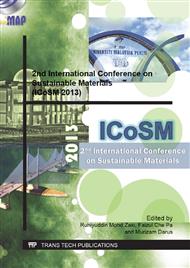p.669
p.674
p.679
p.684
p.692
p.697
p.701
p.707
p.711
Effect of Silver Ions on the Structural and Antibacterial Properties of Bone Replacement Material
Abstract:
Antibacterial materials based on calcium phosphates have wide range of biomedical applications in the prevention of microbial infections. The synthesis of inorganic mineral component of bone i.e. hydroxyapatite was done with the addition of silver (Ag) (5-15 wt %) as antibacterial agent. The wet precipitation synthesis was carried out using diammonium hydrogen phosphate and calcium nitrate as P and Ca precursors. The presence and effect of silver addition on the structure was studied using Fourier Transform-Infrared (FTIR) spectroscopy and Energy Dispersive X-ray (EDX) techniques. The antibacterial properties of all samples were evaluated using Disc Diffusion Technique (DDT) against S. aureus, B. subtilis, P. aeruginosa and E. coli. Antibacterial activities of samples were found to vary depending on the bacterial species and Ag loading percentage. The antibacterial assay suggested that the addition of Ag ions within hydroxyapatite can be effectively provided the required level of antibacterial activity against bacteria.
Info:
Periodical:
Pages:
692-696
Citation:
Online since:
September 2013
Keywords:
Price:
Сopyright:
© 2013 Trans Tech Publications Ltd. All Rights Reserved
Share:
Citation:


